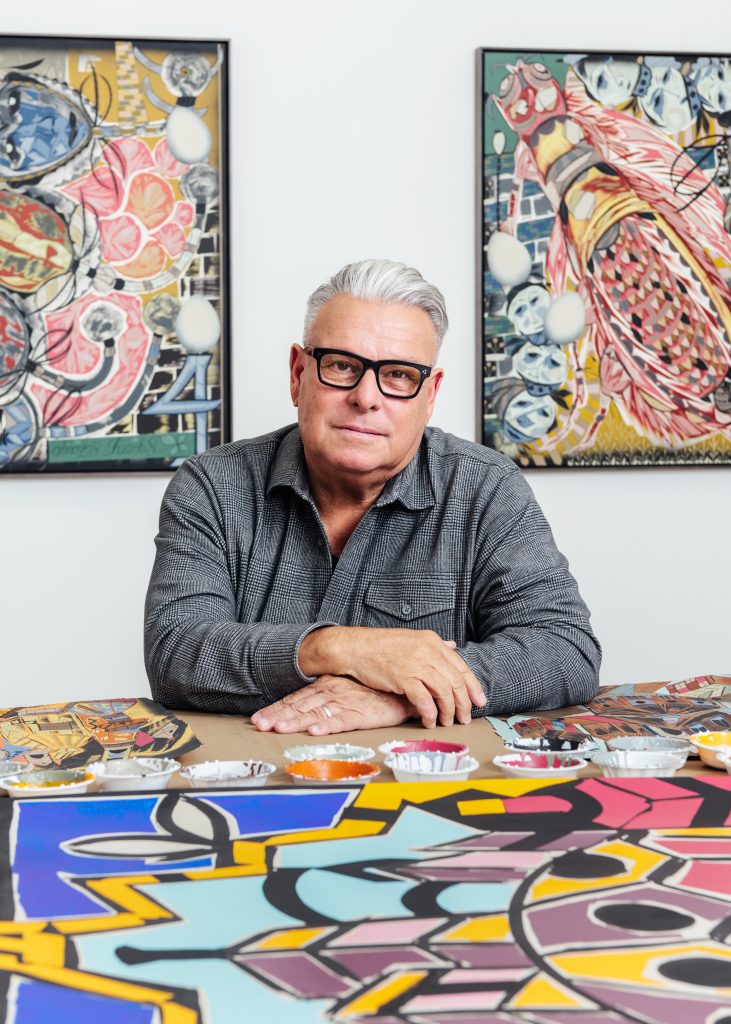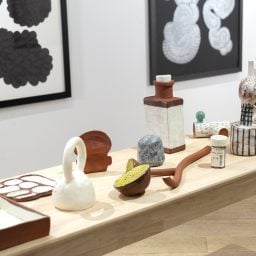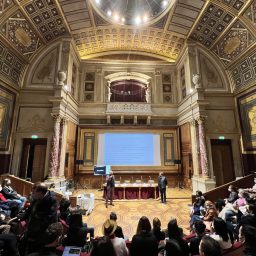Los Angeles-based artist Lari Pittman (b. 1952) has come to be recognized as one of the most significant painters of his generation, with a style recognized for its precise technique, compositional intricacy, symbolic lexicon—and a heavy dose of imagination and even whimsy.
Pittman has recently been the subject of a major traveling retrospective, which premiered at the Hammer Museum, Los Angeles (2019), followed by the Museo Jumex, Mexico City (2022), and will go on view in Shanghai in 2024. Currently, Pittman’s most recent body of work is being shown at Lehmann Maupin, New York, in “Sparkling Cities With Egg Monuments,” on view through November 4, 2023. Though no stranger to working with large-scale canvases, the centerpiece of the exhibition—Sparkling City With Egg Monuments (2022)—which debuted at Museo Jumex last year, is one of the artist’s largest, measuring over 30 feet long. The work is exemplary of the themes and motifs the artist is most well-known for, and imagines a city as a site for hope, generative action, and elative joy.
We caught up with Pittman ahead of the exhibition’s opening to learn more about his fantastical cities and the ideology behind his recurrent use of the egg in his work.

Installation view of “Lari Pittman: Sparkling Cities With Egg Monuments” (2023) at Lehmann Maupin, New York. © Lari Pittman. Courtesy of Lehmann Maupin, New York, Hong Kong, and Seoul.
Your solo show with Lehmann Maupin opens this month. Can you talk about what’s going on view, and the themes or inspirations behind the show?
“Sparkling Cities with Egg Monuments” is both resistance and cri du coeur, a call for expansiveness, civic reciprocity, and above all optimism about the humanity to be found in high-density living. The cities in the paintings are fundamentally conjectural, junky, ebullient, and jerry-rigged. They are deeply interconnected with multiple plazas, pathways, causeways, bridges, and the lights of the dwellings are just being turned on, it’s twilight, the magic hour. These cities are matrilineal and joyfully intersexed. I am no fool, and I understand how this must all sound so silly—but get over it! I am neither a social reporter nor a journalist in pointing out the relationships between cause and effect. I wanted to make “what if” paintings, inspired by the visionary architects of the 18th and 19th centuries that including Claude Nicolas Ledoux, Jean-Jacques Lequeu, Antonio Sant’Elia, Gionanni Battista Piranesi, Etienne-Louis Boullee, the Archigram Collective, and in the magical cityscapes of Remedios Varo and Paul Klee.

Lari Pittman, Sparkling City With Egg Monuments (2022). Courtesy of the artist and Lehmann Maupin.
Sparkling City With Egg Monuments (2022), for which the show is named, is massive in scale. As an artist who is known for working without any assistants, can you tell us about your process from a technical perspective? Where do you start?
I will be 72 soon, and I still work by myself in my studio. If I need help moving a painting, I call my husband of 50 years, the artist Roy Dowell. So far so good! The painting to which you refer is 33 feet in length and is composed of five panels. Over the course of my career, I have always circled around to my love of the Mexican Muralists, especially Diego Rivera. I was preparing for my retrospective exhibition at the Museo Fundacion Jumex in Mexico City, and I wanted to reconnect with my deep appreciation of the muralists but also with a history of a city and a country that has been my other home for the last 16 years. In the making of this painting, which was a bit overwhelming, I started by painting all five panels a turquoise blue and then proceeded to map out the sprawling city by making large paper patterns, much like a dressmaker. I also determined that the entire palette would all be tinted with a very slight amount of burnt umber, to hopefully reduce the cacophony of its value structure and hopefully locate the experience sometime during twilight. After that, layer upon layer and then the fine stitching.
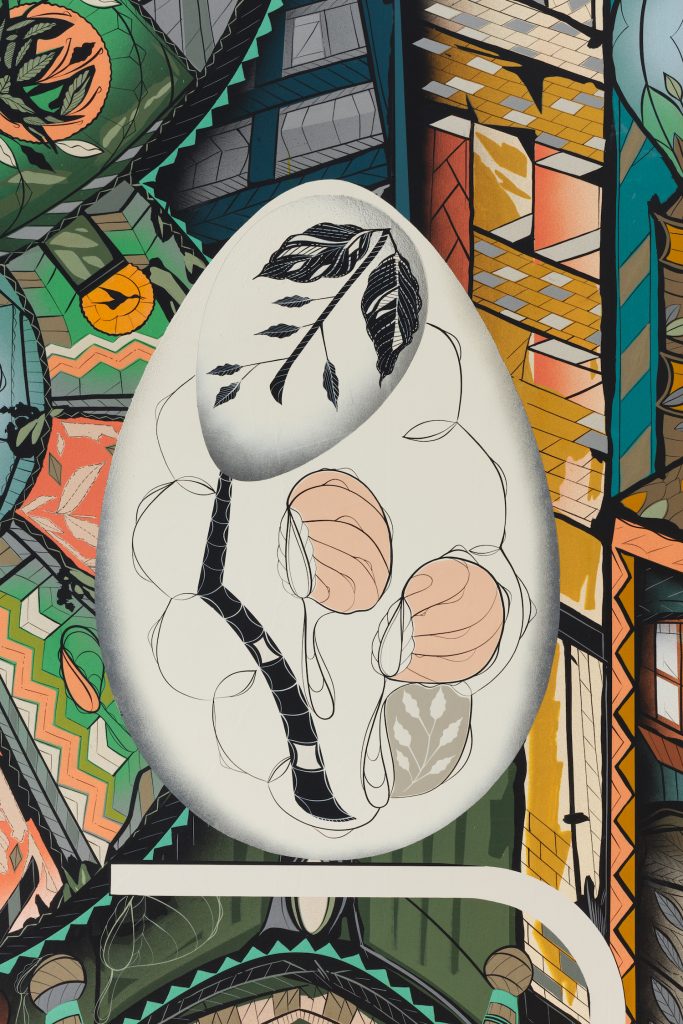
Lari Pittman, detail of Sparkling City With Egg Monuments (2022). © Lari Pittman. Courtesy of Lehmann Maupin, New York, Hong Kong, and Seoul.
The egg as a symbol and compositional element plays a significant role in your new works, and its meaning and use seem quite malleable. What first brought you to the egg motif, and is your employment of it more intuitive or research-based?
The queer population has always and historically been at the vanguard of the malleability of language, clearly born out of survival, dignity, resistance, and complexity of identity. I come out of that noble tradition. Recently, the art historian Darby English asked me if the “eggs were fragile?” I was so taken aback by his question, and it took me an awkward amount of time to answer. Finally answered that the interior world was, and the exterior carapace wasn’t. Perhaps implied here is that the covert language of the imagery is more susceptible to variance and the more overt language of the imagery is more tethered to drag. At the core of attempting to choreograph all the possible shades of meaning is always improvisational and never intuitive. Intuition is overrated and creates redundancies.
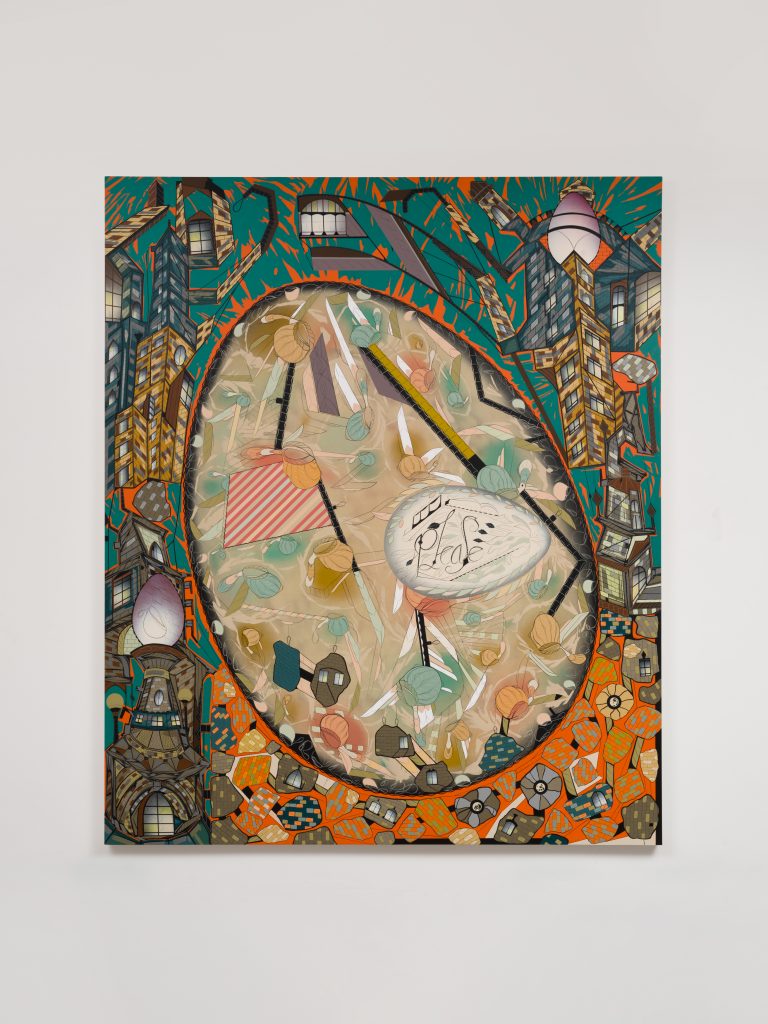
Lari Pittman, Sparkling City With Egg Monuments #3 (2023). © Lari Pittman. Courtesy of Lehmann Maupin, New York, Hong Kong, and Seoul.
The forthcoming exhibition closely follows the retrospective curated by Connie Butler, “Declaration of Independence,” at the Hammer Museum. What was the experience like preparing for a retrospective and looking into your archives? How do you see this affecting your practice moving forward?
New York is so lucky to have Connie Butler back as Director of MoMA PS1! Collaborating with her on both my retrospectives at the Hammer Museum as well as in Mexico City, I simply completely trusted her judgment. Just because I make the work doesn’t mean I automatically understand it, so I place my trust in a curatorial vision and historical expertise. I am thankful to Connie for that. While going over the visual archive of over 40 years, I was reassured that I have not been lazy and welcomed the bittersweet embarrassment of assessing it all. The exhibition at Lehmann Maupin New York is on the tail of this.
Where do you most frequently look for inspiration for new work? What are you currently finding interesting?
I might be in the minority, but I love driving the surface streets of Los Angeles, I know it so well I never use my GPS. My windshield is a cinematic editing device that emphasizes a lateral and polymorphous experience of the city. I simply love this activity and activates my social and structural voyeurism.
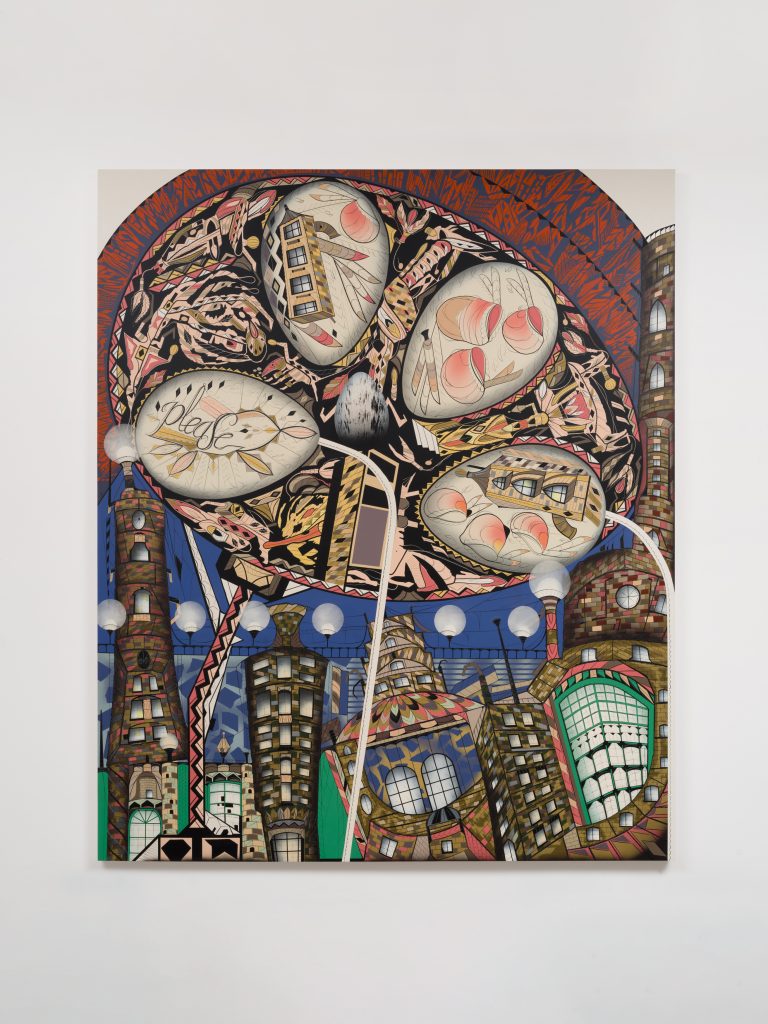
Lari Pittman, Sparkling City With Egg Monuments #5 (2023). © Lari Pittman. Courtesy of Lehmann Maupin, New York, Hong Kong, and Seoul.
The genre of painting experienced significant critical turmoil in the 1970s when you were in school, with some declaring it “dead.” What are your thoughts or observations about the state of painting today?
The ironic beauty of painting is that it is always dead, but constantly needs CPR. The freedom of painting is that it is fundamentally useless.
Can you tell us about what you are currently working on, or what you are planning to work on next?
I just had built a scale model of an important museum in China (to be announced), and I am in the process of nailing down the checklist of between 20–30 paintings. The exhibition opens in late Spring 2024.
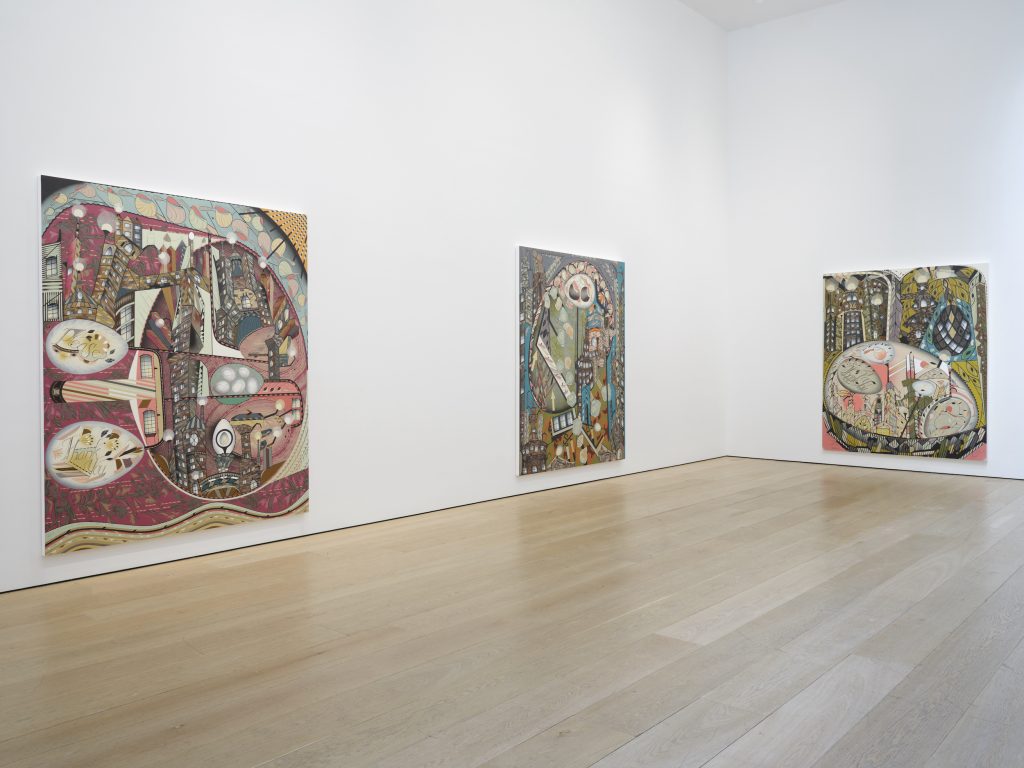
Installation view of “Lari Pittman: Sparkling Cities With Egg Monuments” (2023) at Lehmann Maupin, New York. © Lari Pittman. Courtesy of Lehmann Maupin, New York, Hong Kong, and Seoul.
“Lari Pittman: Sparkling City With Egg Monuments” is on view at Lehmann Maupin, New York, through November 4, 2023.
